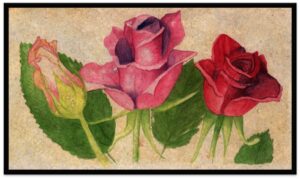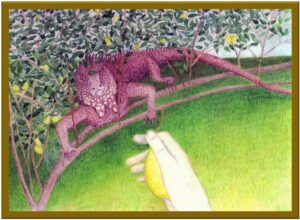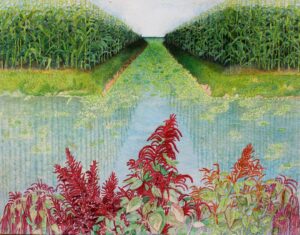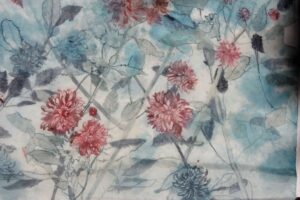Family Jewels
 The first piece of art that Catherine Shapiro ever created was made from plants.
The first piece of art that Catherine Shapiro ever created was made from plants.
At four years old, in her grandparents’ garden at the south-end of Vancouver’s Trout Lake, she pulled iris stalks from the warming ground on a late spring day. Together, she and her cousin braided the stems to create mats.
“It was the first time I’d ever woven anything,” Catherine says today. “I didn’t know it was art, but I thought it was beautiful.”
The neighbourhood of Cedar Cottage—so-named for the groves of cedar trees that commanded the land at the city’s incorporation—had a rich history of good soil to grow food and flowers.
Until her family moved to Los Angeles in 1955, Catherine spent her summers there exploring her grandparents’ acreage, senses overwhelmed by smells, textures and colours.
The balm of her grandfather’s old-fashioned wooden greenhouse. The peppery carpet of bright orange nasturtiums. The size of the apples she pulled from the trees while hoisted on her cousin’s shoulders. The juice from the raspberries they gorged on—the one garden crop they could eat without restraint.
Inside the house, more botanical beauty gleamed from the kitchen cupboards, rows of jarred pickles, jams and preserves. “I thought we were rich,” Catherine says, “and that these were our family jewels.”
Secret Gardens
 In fact, her family were “very much working-class,” and when she was six, her parents relocated to Southern California in search of jobs.
In fact, her family were “very much working-class,” and when she was six, her parents relocated to Southern California in search of jobs.
Their new neighbourhood of Laurel Canyon was full of artists, musicians and actors from the film industry, and Catherine began to imagine her own artistic pursuits. “That’s when I realized it was possible to live a creative life.”
The gardens in her community reflected this new possibility: “They were all so different, and their owners weren’t home very much, so I got to inspect them very closely.”
She remembers how the landscapes bled into one another, the wild chaparral, sage scrub and fountain grass merging at the boundaries. One garden grew geraniums in every color and Catherine picked fresh bouquets for herself every few days. “No one ever stopped me. No one said, ‘What are you doing?’”
A mile up the road she played in the foundation of a burnt-down house where you could see all the way to the ocean. She discovered a citrus garden nearby and often helped herself until one day she saw a creature that frightened her so deeply, she never returned.
“I didn’t know what it was at the time, but it was huge. It must have been an iguana. I’d never seen one before. I had to draw it later in life to figure out what it was.”
The Amaranth Project
 This pattern of art as a pathway to understanding repeats itself across Catherine’s artistic mediums, projects and periods.
This pattern of art as a pathway to understanding repeats itself across Catherine’s artistic mediums, projects and periods.
As a student at the San Francisco Art Institute in the late 1960s, she read an article in Rodale’s Organic Farming and Gardening magazine that would influence her for the rest of her life.
In test gardens in Pennsylvania, back-to-the-landers grew acres of amaranth, once a staple cultivated and worshipped by the Inca, Maya and Aztec for its drought resistance and high nutritional value.
“The first time I saw amaranth, I thought it was mindbogglingly beautiful,” Catherine says. “I started reading about its history, and grew to love it more and more.”
When conquistadors arrived, they outlawed the crop, and burned the fields where it grew. But Indigenous peoples continued to produce it in secret, and women today still play an integral role in protecting the knowledge and traditions of this ancient grain that “could feed the world.”
“As soon as I had a chance, I started growing it, so that I could sit right next to it and draw it,” Catherine says. She wanted to understand its structure; where the leaves sprout; its different colours; and how the corkscrew flowers curl.
“In my art, I use my eraser more than my pencil. I’m always trying to get the real shape of things. If you get the real shape, it makes a difference in how it comes across. I’m not trying to paint realism. I’m just trying to get it to feel like what it really is.”
Indigo Girl
 In the late 1970s, while visiting family in California, Catherine purchased a book about indigo that came with a package of seeds.
In the late 1970s, while visiting family in California, Catherine purchased a book about indigo that came with a package of seeds.
She planted them in her Vancouver garden to great success, but, after harvesting two large pillowcases of dried leaves, she didn’t know what to do. “I was totally intimidated.” Forty years later, she met Sharon Kallis, the artistic director of EartHand Gleaners Society. The topic of indigo came up, and Catherine shared her experience and her desire to grow it again. In short order, Catherine became a mentor at the Means of Production garden and finally began her indigo journey with fellow artist Gloria Tsui.
“We had a blast. It was challenging, but really so much fun,” she says. “What do I love about Indigo? Everything.”
In the years since, Catherine continues to experiment with indigo and other organic materials like gum Arabic; soy milk; cochineal, basil; persimmon and seaweed. She’s applied the paints to cotton, muslin, silk, cast paper and linen pulp.
As usual, she uses her artistic process as a means to an end of learning: “I’m always painting to find out what’s possible.”
Visit Botanical Literacy
Captivated by gardens and plants her entire life, multimedia artist Catherine Shapiro creates environmental artworks that celebrate their beauty while investigating their history.
See more of Catherine Shapiro’s paintings at Roberta Mickelson Gallery in the Yosef Wosk Library (in the VanDusen Visitor Centre) open 10.00am -3.00pm Monday – Wednesday until April 27.
Admission: Free
